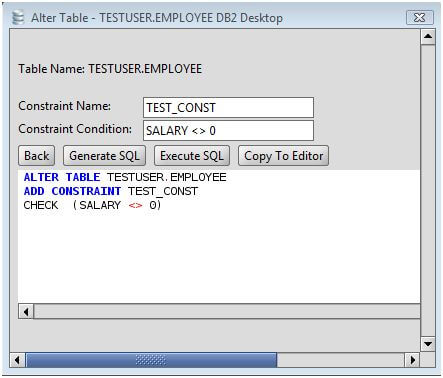SQL constraints are used to specify rules for the data in a table. Constraints are used to limit the type of data that can go into a table. This ensures the accuracy and reliability of the data in the table. If there is any violation between the constraint and the data action, the action is aborted.
That is, we can specify the limit on the type of data that can be stored in a particular column in a table using constraints. We can specify constraints at the time of creating the table using CREATE TABLE statement. These are used to limit the type of data that can go into a table.
APPLIES TO: SQL Server Azure SQL Database Azure Synapse Analytics ( SQL DW) Parallel Data Warehouse. Specifies the properties of a PRIMARY KEY, UNIQUE, FOREIGN KEY, a CHECK constraint , or a DEFAULT definition added to a table by using ALTER TABLE. Transact- SQL Syntax Conventions.
The ADD CONSTRAINT command is used to create a constraint after a table is already created. The SQL CONSTRAINTS are an integrity which defines some conditions that restrict the column to remain true while inserting or updating or deleting data in the column. Table level constraints: Limits whole table data. You can place constraints to limit the type of data that can go into a table.
Such constraints can be specified when the table when the table is first created via the CREATE TABLE statement, or after the table is already created via the ALTER TABLE statement. Sometimes we may decide to add a new constraint to an existing table (to see what are the different types of constraints that can be placed on a database table, please refer to the CONSTRAINT section). A constraint is simply a restriction placed on one or more columns of a table to limit the type of values that can be stored in that column. It maintain the data integrity of the table. For example postal code India country size six digit no below or no more then six digit.
There are quite a few views you might be interested in: sys. The first method is to create the constraint inside of CREATE TABLE as a column constraint. A column constraint applies to only a single column.
The following SQL will create a unique constraint on a new table: Products_2. These rules help in enforcing data integrity. For example if a NOT NULL constraint is defined over a column in a particular table, it means that column will not accepted any NULL values.

Why does SQL Server keep creating a DF constraint ? I either need SQL Server to stop creating this randomly-named constraint OR I need to be able to. Check Constraint is used to specify a predicate that every tuple must satisfy in a given relation. It limits the values that a column can hold in a relation. The predicate in check constraint can hold a sub query. Check constraint defined on an attribute restricts the range of values for that.
Introduction to SQL NOT NULL constraint. The NOT NULL constraint is a column constraint that defines the rule which constrains a column to have non- NULL values only. It means that when we use the INSERT statement to insert a new row into the table, we have to specify the values for the NOT NULL columns. We can create constraints on single or multiple columns of any table.
The SQL mode can be set globally at server startup to affect all clients. Individual clients can set the SQL mode at runtime, which enables each client to select the behavior most appropriate for its requirements. Summary: in this tutorial, you will learn how to use the SQL CHECK constraint to validate data in a column or a set of columns based on a Boolean expression. A CHECK constraint is an integrity constraint in SQL that allows you to specify that a value in a column or set of columns must satisfy a Boolean.
This is called column-level definition. The constraints available in SQL are Foreign Key, Not Null, Unique, Check.
Nincsenek megjegyzések:
Megjegyzés küldése
Megjegyzés: Megjegyzéseket csak a blog tagjai írhatnak a blogba.